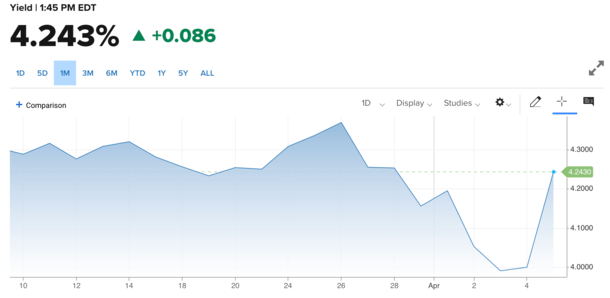If you’ve been paying attention to mortgage rates lately, you might be wondering what on earth is going on.
Mortgage rates appeared to be heading back toward the low 6s before abruptly shifting back toward 7%.
It all took place in the span of a day or two, compounding the matter further.
In fact, Monday was the worst day of the year for mortgage rates thus far, and one of the worst days for rates in recent years.
The takeaway, for now, is that mortgage rates can change fast, and you need to be prepared.
Mortgage Rates Jumped Nearly a Half-Point in Just Two Days
First, let’s assess the damage. In just the past two days, mortgage rates on the popular 30-year fixed increased about 30 basis points (0.30%), per MND.
What was 6.55% on Friday (briefly) was back up to 6.85% this morning, a testament to just how quickly conditions can change.
Meanwhile, Wells Fargo was advertising a 6.625% 30-year fixed, up from 6.25% late last week.
Similar to the stock market, mortgage rates can change daily. In fact, they can change multiple times per day if conditions warrant it.
But there are also days when rates are mostly flat or even unchanged. In recent months, there were weeks where rates did basically nothing.
That was then though. Ever since President Trump’s trade war ratcheted higher, it’s been volatility-central.
If you don’t pay attention for a day, you might be shocked to discover that rates are no longer what you thought they were.
When Trump’s so-called Liberation Day rolled out on April 2nd, the United States imposed tariffs on countries worldwide.
The initial reaction was a slight increase in rates, followed by a nice 15-bp move between April 3rd and 4th.
That got the 30-year fixed down to 6.55%, and had many expecting the momentum to continue.
5% Mortgage Rates Ahead? Not So Fast!

In fact, things were looking so peachy last week that CNBC’s Brian Sullivan tweeted “5% mortgages ahead?”
His post was accompanied by a 10-year bond yield chart that showed it just above 4% (it sunk below that for a short period of time).
Over the past 20+ years, the 30-year fixed has been priced about 170 bps above the 10-year yield.
So if it were 4%, the 30-year fixed would be roughly 5.70%. Lately though, mortgage rate spreads have widened considerably.
This is partially because of prepayment and credit risk, and also because there are fewer buyers of mortgage-backed securities (MBS).
As such, the spread is now close to 265 bps, or about one full percentage point above that recent norm.
In other words, the 30-year fixed would be priced at 6.65% instead if the 10-year were 4%.
Problem is, there appeared to be a flight to safety from stocks to bonds as the sweeping tariffs went into effect, but it was short-lived.
Before long, stocks and bonds were selling off together, and the 10-year bond yield is now back to around 4.25%.
So the swoon in bond yields related to Liberation Day was completely erased, and now we’ve got bloated spreads to boot.
The end result is now a 30-year fixed closer to 7% than the 5s. And really, only another bad day or two from starting with a ‘7’ again.
Especially with the way things are going lately. And it couldn’t come at a worse time, with peak spring home buying now under way.
Coincidentally, mortgage rates tend to be highest in the spring months, so perhaps this shouldn’t come as much of a surprise.
Expect More Interest Rate Volatility as the Global Trade War Evolves
So where do we stand now? Well, it’s becoming clearer by the day that Trump isn’t bluffing on the tariffs.
The tariffs were originally bad for mortgage rates because many expected them to be inflationary.
Then the tariffs were deemed a positive for mortgage rates because they intensified and investors dumped stocks and moved into bonds.
Remember, increased bond demand lowers their yield, aka interest rate.
But then as things got even more intense, tariffs once again hurt mortgage rates as both stocks and bonds sold off in unison.
And as noted, it all seemed to happen in the blink of an eye, a good reminder that low mortgage rates could be here today and gone tomorrow.
That means not looking a gift horse in the mouth and locking your mortgage rate if you’re happy with it. In short, if you like it, lock it.
It’s not entirely clear what the next phase in the trade war will mean for mortgage rates, but there seems to be defensiveness all around, whether it’s stock, bonds, or mortgage rates.
Nobody’s offering a screaming deal in this environment. Some uncertainty is good for interest rates, but not this level of uncertainty.
Simply put, a world that could completely change as the United States attempts to become a manufacturing superpower again while cutting ties with one its biggest trading partner at the same time.
Sure, tomorrow could bring something entirely different, which is the point of this post. We just don’t know what that will be.
One small hint though is the Fed is slated to cut its own fed funds rate four times this year, which tells you monetary policy is expected to become more accommodative.
And that tends to be accompanied by lower mortgage rates. It just might take time, and the day-to-day swings won’t be for the faint of heart.
Read on: Mortgage rates take time to fall, so be patient.

